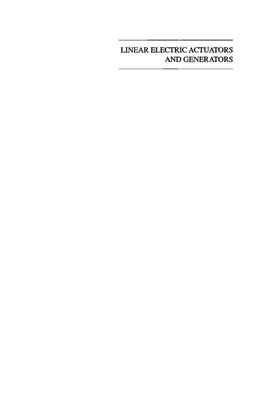Cambridge University Press, 1997. 248 p. ISBN:0521480175,
0521020328
This book deals with LEAs that convert electric energy into controlled mechanical motion of limited travel and LEGs that transform mechanical energy into electric energy. Examples range from loudspeakers and microphones to magnetically levitated material transfer in ultraclean rooms. Much of the literature on linear actuators and generators covers the principles of operation and performance calculations of these devices. Little has been published on their control or on detailed design methodologies. This book presents the first unified treatment of the subject, including the construction, operation, control, and design of LEAs and LEGs. Chapters describe linear induction, permanent-magnet, linear reluctance, switched reluctance, and linear stepper actuators, as well as various types of linear electric generators. The text is amply illustrated with numerous design examples, and will appeal to graduate students and researchers in electrical, mechanical, and design engineering.
First unified approach to the study of linear electric actuators and generators Design guidelines are illustrated by worked-out examples
Extensively illustrated Contents
1. Magnetic circuits, fields and forces;
2. Introduction to linear electric actuators and generators;
3. Linear induction actuators;
4. Linear permanent magnet synchronous actuators;
5. Linear reluctance synchronous actuators;
6. Linear switched reluctance actuators;
7. Linear stepper actuators;
8. Linear electric generators. Review ‘Skilfully written by two distinguished researchers in the field, this highly topical and intriguing book is aimed at those working in industry and universities who approach the emergent technology of linear actuators and alteators. ’ Electromotion
This book deals with LEAs that convert electric energy into controlled mechanical motion of limited travel and LEGs that transform mechanical energy into electric energy. Examples range from loudspeakers and microphones to magnetically levitated material transfer in ultraclean rooms. Much of the literature on linear actuators and generators covers the principles of operation and performance calculations of these devices. Little has been published on their control or on detailed design methodologies. This book presents the first unified treatment of the subject, including the construction, operation, control, and design of LEAs and LEGs. Chapters describe linear induction, permanent-magnet, linear reluctance, switched reluctance, and linear stepper actuators, as well as various types of linear electric generators. The text is amply illustrated with numerous design examples, and will appeal to graduate students and researchers in electrical, mechanical, and design engineering.
First unified approach to the study of linear electric actuators and generators Design guidelines are illustrated by worked-out examples
Extensively illustrated Contents
1. Magnetic circuits, fields and forces;
2. Introduction to linear electric actuators and generators;
3. Linear induction actuators;
4. Linear permanent magnet synchronous actuators;
5. Linear reluctance synchronous actuators;
6. Linear switched reluctance actuators;
7. Linear stepper actuators;
8. Linear electric generators. Review ‘Skilfully written by two distinguished researchers in the field, this highly topical and intriguing book is aimed at those working in industry and universities who approach the emergent technology of linear actuators and alteators. ’ Electromotion

